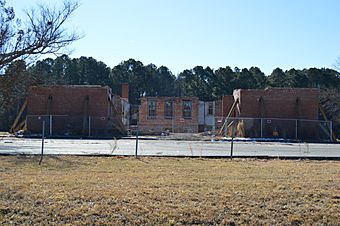Nansemond County Training School facts for kids
|
Nansemond County Training School
|
|

Front of the school, while undergoing reconstruction in 2018
|
|
| Location | 9307 Southwestern Boulevard, Suffolk, Virginia |
|---|---|
| Area | Less than 1 acre (0.40 ha) |
| Built | 1924 |
| Architectural style | Late 19th And Early 20th Century American Movements |
| MPS | Rosenwald Schools in Virginia MPS |
| NRHP reference No. | 04000847 |
Quick facts for kids Significant dates |
|
| Added to NRHP | August 11, 2004 |
The Nansemond County Training School, also known as Southwestern High School, is a special historic building in Suffolk, Virginia. It was once a Rosenwald School, which were schools built for African-American students during a time when schools were separated by race.
What is a Rosenwald School?
A Rosenwald School was one of many schools built for African-American children in the early 1900s. These schools were created through a partnership between Booker T. Washington, who was a famous educator, and Julius Rosenwald, who was the head of Sears, Roebuck and Company. They worked together to improve education for Black students in the Southern United States.
Julius Rosenwald provided money to help build these schools. Local communities also contributed funds, land, and labor. This partnership helped build over 5,000 schools, shops, and teacher homes across 15 states. These schools were very important because they gave many African-American children a chance to get an education when other options were limited.
History of the School
The Nansemond County Training School was built in 1924. It was the first public high school for Black students in Nansemond County, Virginia. The school taught both younger children in primary grades and older students in secondary grades.
The building is one story tall. It has a main part in the middle with a covered porch that is set back a bit. On each side of the main building, there are wings. The roof is made of tin and has a sloped shape. There was also a separate building on the property that was first used as a cafeteria. Later, this building became an extra classroom.
The school served the community for many years. It closed its doors after the 1969–70 school year. In 2004, the Nansemond County Training School was added to the National Register of Historic Places. This means it is recognized as an important historic site in the United States.
See Also
- Nansemond Collegiate Institute (1905–1939), another important school for Black students in the area.



